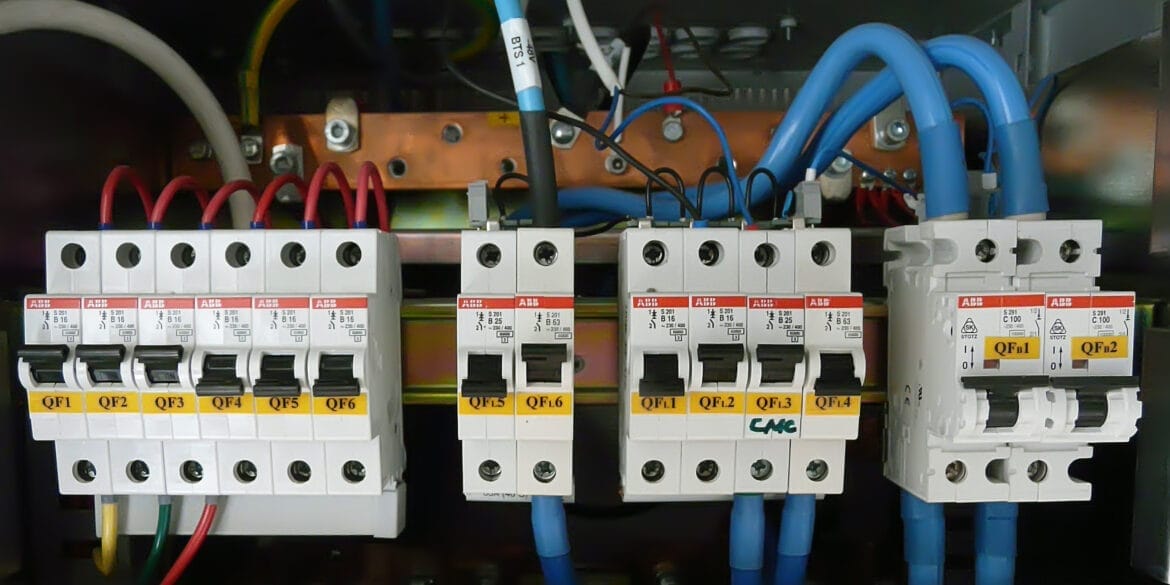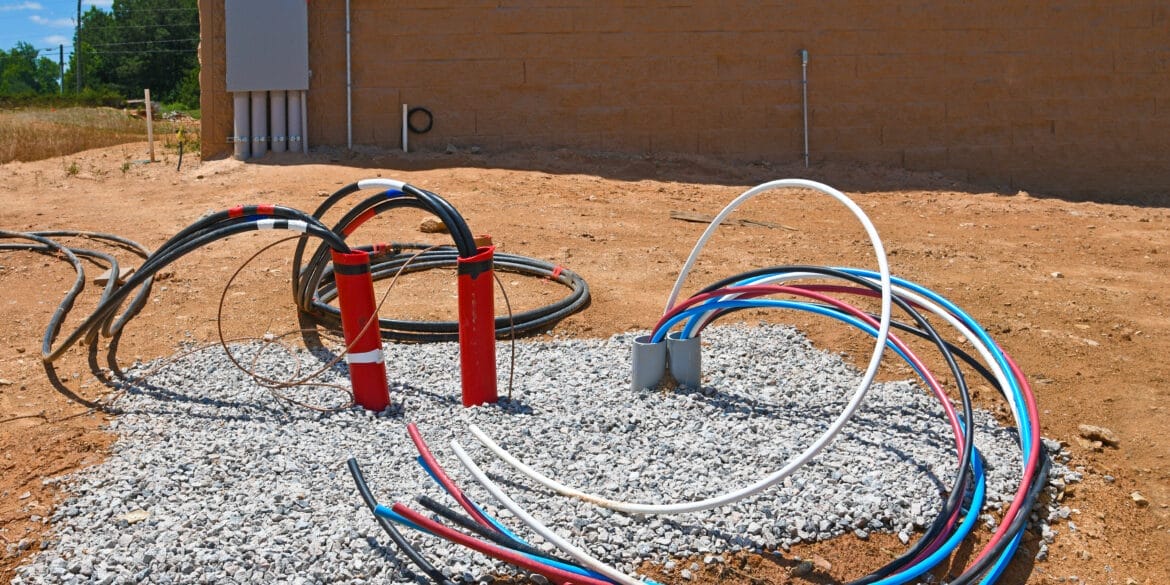
After diversity maximum demand
Under normal operating conditions, not all the individual electrical equipment of an installation will operate at full load simultaneously. Therefore, the total circuit current is estimated using diversity factors and is often described as the ‘after diversity maximum demand’.
The diversity factors applicable to a given circuit in an installation depend on the type of installation (e.g., residential, commercial, industrial) and other factors.
You can calculate the Maximum Demand by hand or using software.
Cable Pro Web Software can perform Maximum Demand calculations by automatically applying the standards’ rules and balancing the loads to minimise the demand.
A double general power outlet (GPO) should be treated as two (2) points for the purpose of maximum demand calculations. For example, 19 double 10 A GPO’s equates to 38 points.
Tables for maximum demand calculation
Standards, such as the Wiring Rules AS/NZS 3000, provide diversity factors for typical installations and equipment loads.
The tables for domestic and non-domestic installations below are provided below. A table for calculating energy demand for non-domestic installations is also provided.
A common question is how to treat double socket outlets in maximum demand calculations. Double-socket outlets should be treated as two separate points.
Disclaimer: No responsibility is assumed for the accuracy of the Tables below. Further, additional notes to these tables have not been included.
Table C1 Maximum Demand- Single and Multiple Domestic Electrical Installations
| Load group | Single domestic electrical installation or individual living unit per phase | Blocks of living units | ||
|---|---|---|---|---|
| 2 to 5 living units per phase | 6 to 20 living units per phase | 21 or more living units per phase | ||
| Loading associated with individual units | ||||
| A. Lighting (i) Except (ii) and load group H below | 3 A for 1 to 20 points + 2 A for each additional 20 points or part thereof | 6 A | 5 A + 0.25 A per living unit | 0.5 A per living unit |
| (ii) Outdoor lighting exceeding a total of 1000 W | 75% connected load | No assessment for the purpose of maximum demand | ||
| B. (i) Socket-outlets not exceeding 10 A Permanently connected electrical equipment not exceeding 10 A and not included in other load groups | 10 A for 1 to 20 points + 5 A for each additional 20 points or part thereof | 10 A + 5 A per living unit | 15 A + 3.75 A per living unit | 50 A + 1.9 A per living unit |
| (ii) Where the electrical installation includes one or more 15 A socket-outlets, other than socket-outlets provided to supply electrical equipment set out in groups C, D, E, F, G, and L | 10 A | |||
| (iii) Where the electrical installation includes one or more 20 A socket-outlets other than socket-outlets provided to supply electrical equipment set out in groups C, D, E, F, G, and L | 15 A | |||
| C. Ranges, cooking appliances, laundry equipment or socket-outlets rated at more than 10 A for the connection thereof | 50% connection load | 15 A | 2.8 A per living unit | |
| D. Fixed space heating or airconditioning equipment, saunas or socket-outlets rated at more than 10 A for the connection thereof | 75% connected load | 75% connected load | 75% connected load | |
| E. Instantaneous water heaters | 33.3% connected load | 6 A per living unit | 100 A + 0.8 A per living unit | |
| F. Storage water heaters | Full-load current | 6 A per living unit | 100 A + 0.8 A per living unit | |
| G. Spa and swimming pool heaters | 75% of the largest spa, plus 75% of the largest swimming pool, plus 25% of the remainder | |||
| H. Communal lighting | Not applicable | Full connected load | ||
| I. Socket-outlets not included in groups J and M below Permanently connected electrical equipment not exceeding 10 A | Not applicable | 2 A per point, up to a maximum of 15 A | ||
| J. Appliances rated at more than 10 A and socket-outlets for the connection thereof- (i) Clothesdryers, water heaters, self-heating washing machines, wash boilers | Not applicable | 50% connected load | ||
| (ii) Fixed space heating, airconditioning equipment, saunas | Not applicable | 75% connected load | ||
| (iii) Spa and swimming pool heaters | Not applicable | 75% of the largest spa plus 75% of the largest swimming pool, plus 25% of the remainder | ||
| (vi) Charging equipment associated with electric vehicle | 100% connected load | 90% connected load | 75% connected load | |
| K. Lifts | In accordance with Paragraph C2.4.1 and Table C2 | In accordance with Paragraph C2.4.1 and Table C2, for determination of size of submains | ||
| L. Motors | In accordance with Paragraph C2.4.1 and Table C2, Column 2 | In accordance with Paragraph C2.4.1 and Table C2, Column 2 | ||
| M. Appliances, including socket-outlets other than those set out in groups A to L above, e.g. pottery kilns, welding machines, radio transmitters, X-ray equipment and the like | Connected load 5 A or less: No assessment for purpose of maximum demand | Connected load 10 A or less: No assessment for purpose of maximum deman | ||
| Connected load over 5 A: By assessment | Connected load over 10 A: By assessment | |||
Table C2 Maximum Demand Non-Domestic Electrical Installations
| Load group | Residential institutions, hotels, boarding houses, hospitals, accommodation houses, motels | Factories, shops, stores, offices, business premises, schools and churches |
|---|---|---|
| A. Lighting other than in load group F | 75% connected load | Full connected load |
| B. (i) Socket-outlets not exceeding 10 A other than those in B (ii) | 1000 W for first outlet plus 400 W for each additional outlet | 1000 W for first outlet plus 750 W for each additional outlet |
| (ii) Socket-outlets not exceeding 10 A in buildings or portions of buildings provided with permanently installed heating and cooling equipment or both | 1000 W for first socket-outlet, plus 100 W for each additional outlet | |
| (iii) Socket-outlets exceeding 10 A | Full current rating of highest rated socket-outlet, plus 50% of full current rating of remainder | Full current rating of highest rated socket-outlet, plus 75% of full current rating of remainder |
| C. (i) Appliances for cooking, heating and cooling, including instantaneous water heaters, but not appliances included in groups D and J below | Full connected load of highest rated socket-outlet, plus 50% of full current rating of remainder | Full connected load of highest rated socket-outlet, plus 75% of full current rating of remainder |
| (ii) Charging equipment associated with electric vehicles | Full connected load of highest rated socket-outlet, plus 75% of full current rating of remainder | Full connected load of highest rated socket-outlet, plus 75% of full current rating of remainder |
| D. Motors other than in E and F below | Full current rating of highest rated socket-outlet, plus 50% of full current rating of remainder | Full load of highest rated motor, plus 75% of full load of second highest rated motor, plus 50% of full load of remainder |
| E. Lifts | (i) Largest lift motor _ 125% full load (ii) Next largest lift motor _ 75% full load (iii) Remaining lift motors _ 50% full load For the purpose of this load group, the full-load current of a lift motor shall mean the current taken from the supply when lifting maximum rated load at maximum rated speed |
|
| F. Fuel dispensing units | (i) Motors : First motor _ full load Second Motor _ 50% full load Additional motors _ 25% full load (ii)Lighting _ full connected load |
|
| G. Swimming pools, spas, saunas, thermal storage heaters including water heaters, space heaters, and similar arrangements | Full-load current | |
| H. Welding machines | In accordance with Paragraph C2.5.2, taking into account power factor correction | |
| J. X-ray equipment | 50% of the full load of the largest x-ray unit, additional units being ignored | |
| K. Other equipment not covered by load groups above | By assessment | |
Table C3 Maximum Demand – Energy Demand Method for non-Domestic Installations
| Type of occupancy | Energy demand | ||
|---|---|---|---|
| Range, VA/m2 | Average, VA/m2 | ||
| Offices | Light and Power Air conditioning -cooling -reverse cycle -zonal reheat -variable volume | 40-60 30-40 20-30 40-60 20 | 50 35 25 50 20 |
| Carparks | Open Air EV charging Basement EV charging | 0-10 5-15 10-20 10-30 | 5 10 15 20 |
| Retail Shops | Light and Power Air conditioning | 40-100 20-40 | 70 30 |
| Warehouses | Light and Power Ventilation Special Equipment | 5-15 5 (use load details) | 10 5 |
| Light industrial | Light and Power Ventilation Air conditioning Special Equipment | 10-20 10-20 30-50 (use load details) | 15 15 40 |
| Taverns, licensed clubs | الإجمالي | 60-100 | 80 |
| Theatres | الإجمالي | 80-120 | 100 |








